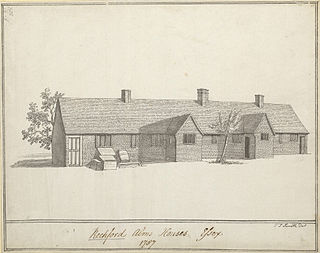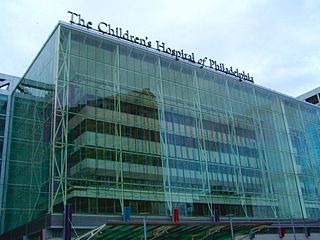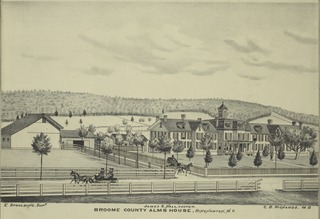
The Philippine General Hospital, simply referred to as UP–PGH or PGH, is a tertiary state-owned hospital administered and operated by the University of the Philippines Manila. It is designated as the National University Hospital, and the national government referral center. It stands within a 10-hectare (25-acre) site located at the UP Manila Campus in Ermita, Manila. PGH has 1,100 beds and 400 private beds, and has an estimated of 4,000 employees to serve more than 600,000 patients every year.

A nursing home is a facility for the residential care of elderly or disabled people. Nursing homes may also be referred to as care homes, skilled nursing facilities (SNF) or long-term care facilities. Often, these terms have slightly different meanings to indicate whether the institutions are public or private, and whether they provide mostly assisted living, or nursing care and emergency medical care. Nursing homes are used by people who do not need to be in a hospital, but cannot be cared for at home. The nursing home facility nurses have the responsibilities of caring for the patients' medical needs and also the responsibility of being in charge of other employees, depending on their ranks. Most nursing homes have nursing aides and skilled nurses on hand 24 hours a day.

An almshouse was charitable housing provided to people in a particular community, especially during the Middle Ages. They were often targeted at the poor of a locality, at those from certain forms of previous employment, or their widows, and at elderly people who could no longer pay rent, and are generally maintained by a charity or the trustees of a bequest. Almshouses were originally formed as extensions of the church system and were later adapted by local officials and authorities.
A poorhouse or workhouse is a government-run facility to support and provide housing for the dependent or needy.

Pennsylvania Hospital is a private, non-profit, 515-bed teaching hospital located in Center City Philadelphia and is part of the University of Pennsylvania Health System. Founded on May 11, 1751, by Benjamin Franklin and Dr. Thomas Bond, Pennsylvania Hospital is one of the earliest established public hospitals in the United States. It is also home to America's first surgical amphitheatre and its first medical library. The hospital's main building, dating to 1756, is a National Historic Landmark.

The Children's Hospital of Philadelphia, also known by its acronym CHOP, is a children's hospital in Philadelphia, Pennsylvania. Its primary campus is located in the University City neighborhood of West Philadelphia on the campus of the University of Pennsylvania. The hospital has 594 beds and more than one million outpatient and inpatient visits annually. It is one of the world's largest and oldest children's hospitals and the first hospital dedicated to the healthcare of children.

University City is the easternmost portion of West Philadelphia, encompassing several Philadelphia universities. It is situated directly across the Schuylkill River from Center City.
Penn Presbyterian Medical Center, sometimes called Presby, is a hospital located in the University City section of West Philadelphia. It was founded by Reverend Ephraim D. Saunders in 1871 and formally joined the University of Pennsylvania Health System in 1995. Penn Presbyterian is spread out on a campus bounded by Market Street, Powelton Avenue, 38th Street, and Sloan Street.

Satterlee General Hospital was the largest Union Army hospital during the American Civil War. Operating from 1862 to 1865 in Philadelphia, Pennsylvania, its physicians and nurses rendered care to thousands of Union soldiers and Confederate prisoners. After its patient population spiked following the battles of Bull Run and Gettysburg, this hospital became the second-largest in the country with 34 wards and hundreds of tents containing 4,500 beds.

Alice Fisher was a nursing pioneer. During her brief career at the Philadelphia General Hospital (PGH) she improved the standards of care at the institution and created the hospital's nursing school.

Thomas Story Kirkbride was a physician, alienist, hospital superintendent for the Institute of the Pennsylvania Hospital, and primary founder of the Association of Medical Superintendents of American Institutions for the Insane (AMSAII), the organizational precursor to the American Psychiatric Association. Along with Dr. Benjamin Rush he is considered to be the father of the modern American practice of psychiatry as a specific medical discipline. His directive and organization of institutions for the insane were the gold-standard of clinical care in psychiatry throughout the 19th century.

The Taunton Alms House is a historic alms house at 350 Norton Avenue in Taunton, Massachusetts. The present facility was built in 1876 as a poorhouse, and was enlarged in the 20th century after its conversion to a nursing home. The building is architecturally a fine example of institutional Italianate architecture, and is an important reminder of progressive social services provided in the late 19th century. The building was added to National Register of Historic Places in 1984.

A hospital is a health care institution providing patient treatment with specialized health science and auxiliary healthcare staff and medical equipment. The best-known type of hospital is the general hospital, which typically has an emergency department to treat urgent health problems ranging from fire and accident victims to a sudden illness. A district hospital typically is the major health care facility in its region, with many beds for intensive care and additional beds for patients who need long-term care. Specialized hospitals include trauma centers, rehabilitation hospitals, children's hospitals, seniors' (geriatric) hospitals, and hospitals for dealing with specific medical needs such as psychiatric treatment and certain disease categories. Specialized hospitals can help reduce health care costs compared to general hospitals. Hospitals are classified as general, specialty, or government depending on the sources of income received.
The Friends' Almshouse of Philadelphia was founded in 1713 by the city's Quaker leadership to help destitute members of the Society of Friends, although people of other creeds were sometimes admitted. As such, this was the first institution in America to care for poor citizens. The combination poorhouse and workhouse occupied two small buildings built especially for it on the south side of Walnut Street between Third and Fourth Streets. The houses were augmented with a substantial brick building fronting Walnut Street in 1729.

Ann Preston was an American physician, activist, and educator.
Rufus Wyman (1778–1842) was an American physician. He was the first physician and superintendent of the Asylum for the Insane, renamed in 1823 to McLean Hospital, part of the Massachusetts General Hospital system, and the first mental hospital in the state.
John B. Chapin M.D. (1829-1918) was an American physician and mental hospital administrator. He was an advocate for the removal of mentally ill patients from the almshouses in New York State to a hospital setting and helped to pass a state law that provided hospital care for the patients.

The Broome County Alms House, was located in the town of Dickinson, three miles north of Binghamton in Broome county, New York. The red brick building operated as a shelter for the poor, take care of the sick, disabled, mentally unwell, widowed, and orphaned persons in the community until c. 1960. The goal of the almshouse was to both help break the cycle of poverty and to care for members of the community who had no means of caring take of themselves. The building was demolished on February 5, 2010.

The Pennsylvania Almshouse Painters were three self-taught artists; Charles C. Hofmann, Louis Mader and John Rasmussen, who are almost exclusively known for their paintings of the almshouse in Berks County, Pennsylvania, done in an early folk art style. They were all born in Germany.















